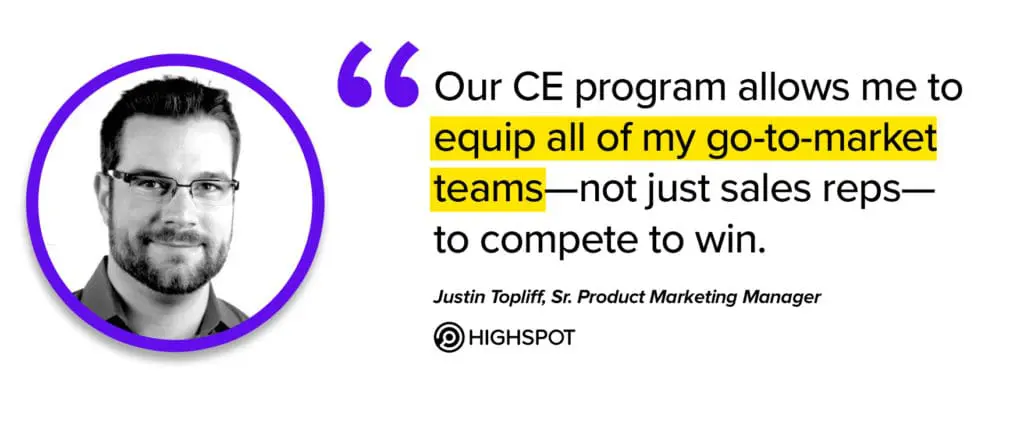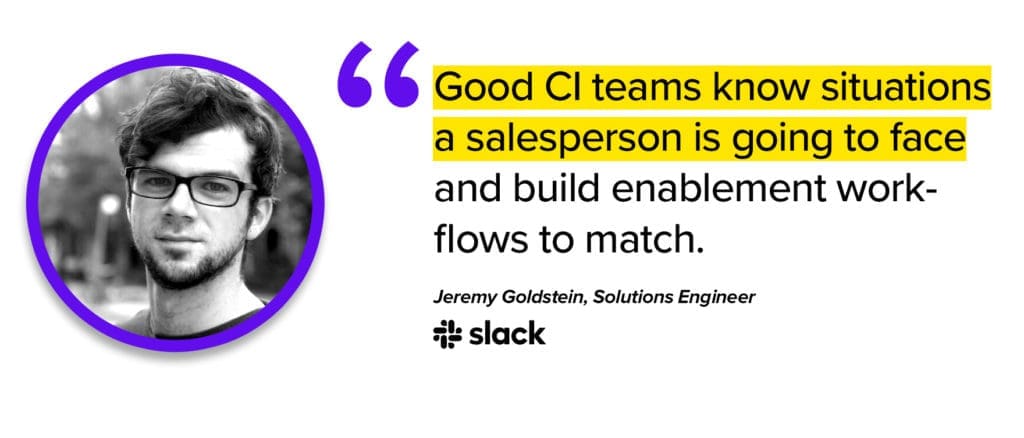Klue Compete
The Competitive Enablement Platform
Learn More
FIND OUT MORE >

Having the best product loaded with the most cutting-edge features might earn your company headlines, but it’s not a sure fire strategy for long-term success.
The battleground for customer experience won’t be won by product attributes, flashy marketing, or even price. It will be won by the seller understanding the customers’ needs and competitive options and activating those insights to win.


SCIP research has shown that customer experience (CX) will have the greatest impact on competition and revenue growth in the next three years. Significantly above new product development, M&A, or increased marketing spend.
Consumers and B2B customers alike expect an outstanding, consistent, and increasingly personalized experience, across all touchpoints of the sales and service lifecycle.
What’s the upside of getting the customer experience right? Consumers are willing to pay a premium of up to 16% for a great experience (PwC research). And B2B buyers are 34% more likely to buy from a supplier with a reputation for delivering an excellent experience (Deloitte Digital).
Ultimately, excellent CX gives companies a competitive edge: Forrester has shown that customer-focused companies increase revenues 1.4x more quickly than peers.
What’s the “so what” for revenue teams? Far from being the domain of post-sales service, CX cuts across the customer journey. Revenue teams play a critical role as the proverbial tip of the spear, as Sunil Murthy, VP of Strategic Marketing & Business Development at Transient Plasma Systems notes:
“Our competitive intelligence showed that we were losing 50% of our aftermarket business to competitors, because customers viewed our go-to-market approach as an ‘afterthought’. Once we understood the underlying reasons, we established competitive tiers and pricing, and improved our reach and service quality. As a result, we grew that business nearly 25% in three years.”


Unfortunately, many organizations aren’t aware of that Insight Gap, between what customers want, and the buying experience that revenue teams are delivering.
| What Customers Expect | What They’re Actually Getting |
| 85% of buyers expect sales reps to demonstrate a firm understanding of their business 86% of buyers expect a trusted advisor relationship with sales reps Source: Salesforce, State of the Connected Consumer | 57% of buyers say sales reps don’t know enough about their business 73% of buyers say most sales interactions feel transactional, rather than consultative 54% of customers say it generally feels like sales, service, and marketing don’t share information. |
At its core, there are two causes of this gap:
The second cause is especially pernicious. Most established players have access to a treasure trove of customer and competitor data that can be used to optimize offerings, pricing, messaging, etc.
However, according to McKinsey, instead of turning this unique asset into a durable competitive advantage, nearly 90% of incumbents struggle, opening up a critical vulnerability to new entrants.
This can lead to lost deals and lost trust, according to Jeremy Goldstein, Solutions Engineer at Slack:
“As a salesperson, your biggest fear is if you say something incorrect about a competitor, and a client knows you’re incorrect, you’ve lost all credibility. Good CI teams know the situations a salesperson is going to face and build enablement workflows to match those situations.”
Having the right insights is table stakes. Bringing those insights to life for revenue teams in the right format at the right time is a whole other ball game. SCIP & Klue research discovered that this is the #1 complaint from intelligence stakeholders: the insights exist, but they’re not available when and where they’re needed most.


On the flip side, what’s the #1 complaint from buyers? That the sales person didn’t understand them, their needs, or their business.
So how can organizations leverage what they know about their customers, competitors, and operating environment to build trust with customers, increase win rates and deliver an outstanding customer experience? And do it at scale?
Enter Competitive Enablement. (CE)
While competitive intelligence and competitive enablement are related, let’s take a moment to differentiate the two.
| Defining Competitive Intelligence | |
Competitive Intelligence is a discipline that enables organizations to reduce strategic risk and increase revenue opportunities by having a deep understanding of what has happened, what is happening, and what may happen in their operating environment. (SCIP 2021) |
| Defining Competitive Enablement | |
Competitive Enablement is a repeatable and scalable set of practices that allow organizations to deliver customer and competitive insights directly to employees, in the tools where they work, so they can be leveraged to win against the competition and increase revenue. |
Whereas Competitive Intelligence can be used to support a wide variety of growth levers (M&A, IP, NPD, GTM, sales & marketing effectiveness, etc.), Competitive Enablement is laser focused on helping Revenue Teams (sales, marketing, customer success) “ring the cash register”, at scale.
“Competitive enablement and sales enablement go hand in hand. If you’re not thinking about investing and coordinating them now, it will bite you. Two years ago, Highspot was a startup, now we’re a $2.3B unicorn. Our competitive landscape, and what’s at stake, saw change of the same magnitude. Our CE program allows me to be in more places at once, enable more sellers at once, and equip all of my go-to-market teams–not just sales reps–to compete to win.”
Justin Topliff, Sr. product marketing manager, Highspot
What’s the benefit of getting this right? Organizations that effectively leverage relevant insights in the sales process enjoy 85% higher revenue growth and 25% higher gross margins.
Effective Competitive Enablement doesn’t happen by accident. It requires a clear vision, cross-functional alignment, and a spirit of continuous improvement, not to mention the right insights, processes and tools.
But when it comes to CE, what does “good look like”?
Fortunately, we can leverage Klue’s Competitive Enablement maturity model as a roadmap on the journey to world-class.
The maturity model assesses sophistication in 5 distinct areas: objectives, people, processes, technologies, and KPI/metrics.
Like any maturity model, migrating just one level up takes significant determination and effort – no organization can go from “Ad Hoc” to “Transforming” overnight (or in a few quarters, for that matter).
The maturity model is a useful tool for building a culture of competitive enablement, not a “flavor of the month” initiative that quickly fizzles out.
Like the Toyota Production System or the Challenger Sale, competitive enablement, especially at the higher levels of maturity, requires organizational commitment.
But as we’ve shown above, the rewards for organizations that embrace competitive enablement are substantial.
One example of this is Juniper Networks. Here’s what Chris Agnoli, Competitive Enablement Lead at Juniper Networks, had to say during his appearance on the ‘CE Show’.
“The old way of competitive intelligence is a one way conversation where somebody in a cubicle is doing research and they’re putting things out from their perspective and vomiting it out to the entire team. What we’re driving is very much a two-way street. We leverage the experience that our best solutions, architects and salespeople have in the field to help drive and make sure that the content that’s being created is impactful.”
The results from this approach? Sellers actually trust and use the intelligence at their disposal. Trust that translates into the same sellers increasing their consumption of Chris’ competitive content by over 187%.
There’s no one-size-fits-all organizational model for CE. Many companies have a CI function with strong CE capabilities, while others run CE and CI separately.
Whatever organizational model is being used, CE is a critical competency for arming revenue teams with insights about customer needs and competitive options to win deals and deliver outstanding customer experiences.
“Workato competes in a massive segment approaching 40% CAGR, with over 70 companies across 4 Gartner Quadrants – all chasing a $600B TAM. I simply can’t do my job and meet the needs of so many teams without a Competitive Enablement platform and process in place.”
Matt Coblentz, Competitive Intelligence Manager, Workato
Providing an awesome customer experience doesn’t happen by accident. Your entire organization plays a role. For Competitive Enablement, that role is activating relevant insights about your customers and the competitive landscape that will help you win deals.
We’ve shown you that customers reward organizations that deliver a great experience.
B2B buyers are 34% more likely to buy from suppliers with a reputation for great CX. But customers are often frustrated with the sales process.
Over half of buyers say sales reps don’t know enough about their business and many sellers don’t activate the insights they already have.
90% of established players struggle to use customer insights to maintain their competitive edge,
However, for the organizations that are building out CE programs, like Juniper Networks, Workato, and others, the rewards are substantial.
Organizations that effectively leverage insights in the sales process enjoy 85% higher revenue growth.
So how can your organization take the next steps towards CE? In addition to the CE Maturity Model report, there are several case studies at SCIP IntelliCon that will help you build a high-performing CE program, including:
Whatever product you make, or industry you’re in, there’s a huge opportunity for CE to help you increase revenues, margins, and deliver an awesome customer experience. What are you waiting for?


Competitive Enablement
The topic of Large Language Models (LLMs) has a lot of confusion. Here's what you need to know about how Klue is working with them.


Competitive Enablement
Product Marketing
If your competitive intel game is too strong for automation, too pure for data privacy, and too rebellious for accuracy — then Klue AI is probably not for you.


Let’s do it. Tell us a bit about yourself and we’ll set up a time to wow you.
Let's do it. Tell us a bit about yourself and we'll set up a time to wow you.
XLet's do it. Tell us a bit about yourself and we'll set up a time to wow you.
XSubscribe to get our latest AI functionality and news in your inbox.
XOur Buyer Pulse feature, set to launch in Q2 2024, offers valuable insights into the factors influencing buyer decisions in your pipeline. By signing up for the waitlist, we can better gauge interest and proactively engage with you to streamline the setup and integration process before the feature becomes widely available.
X